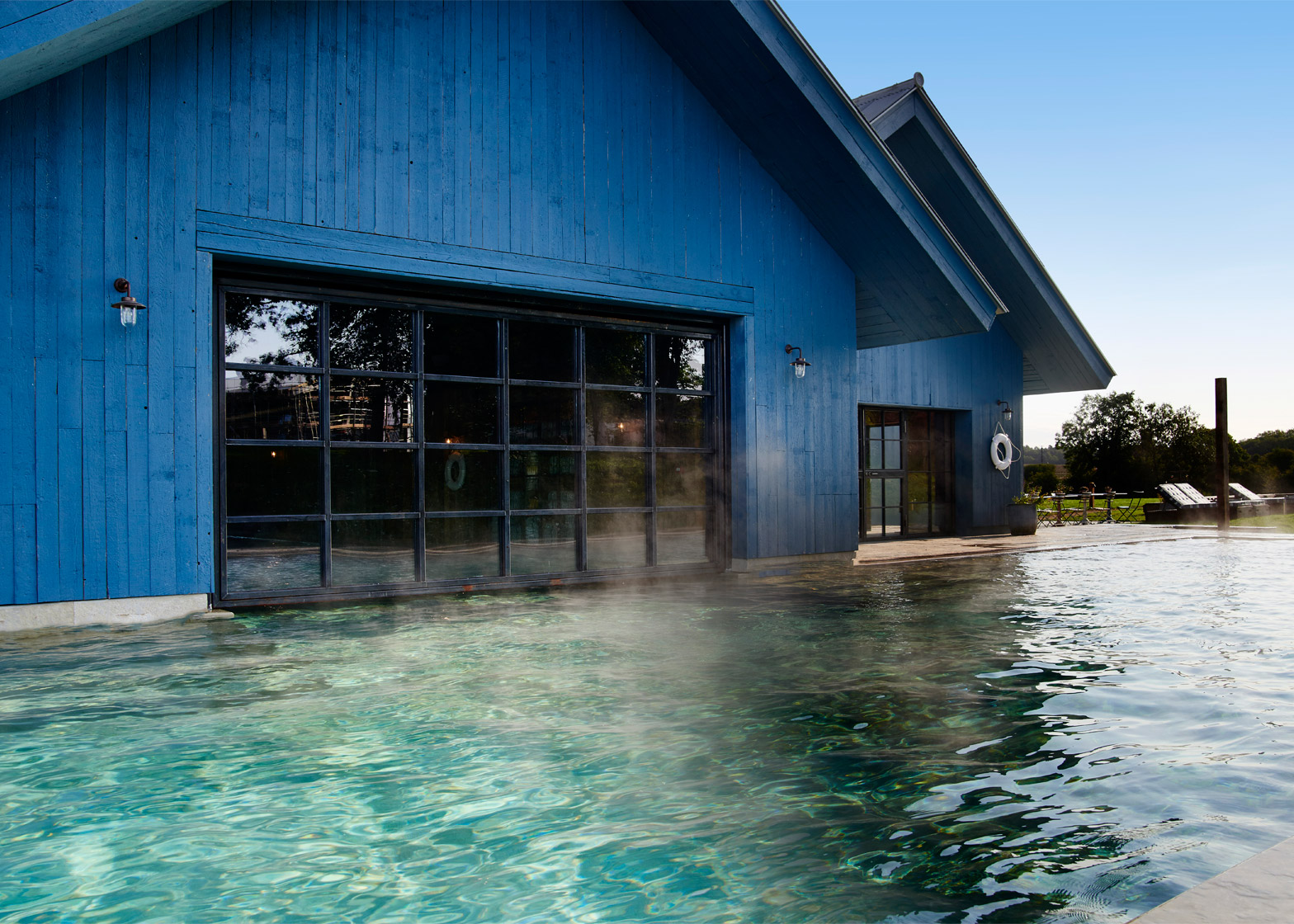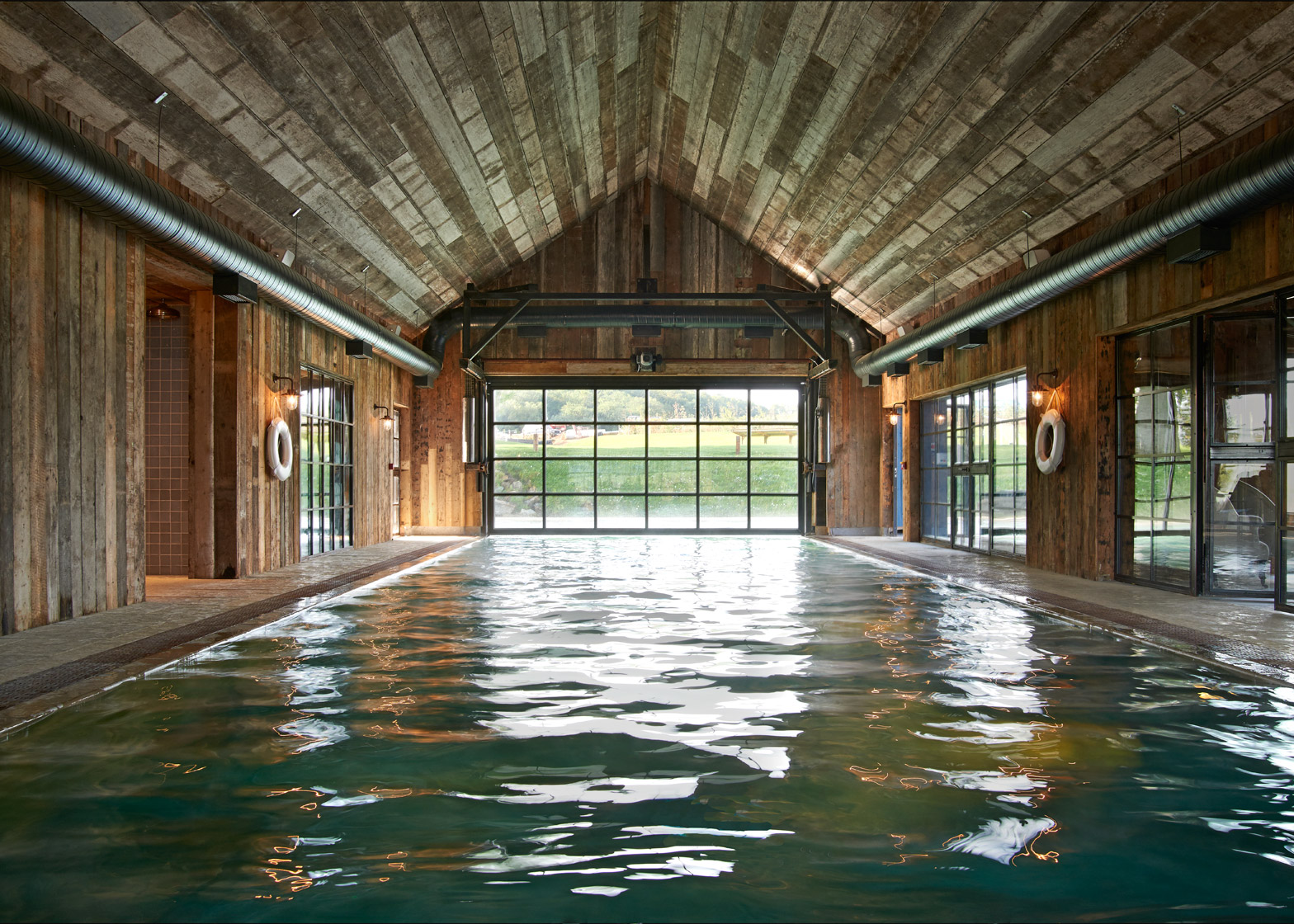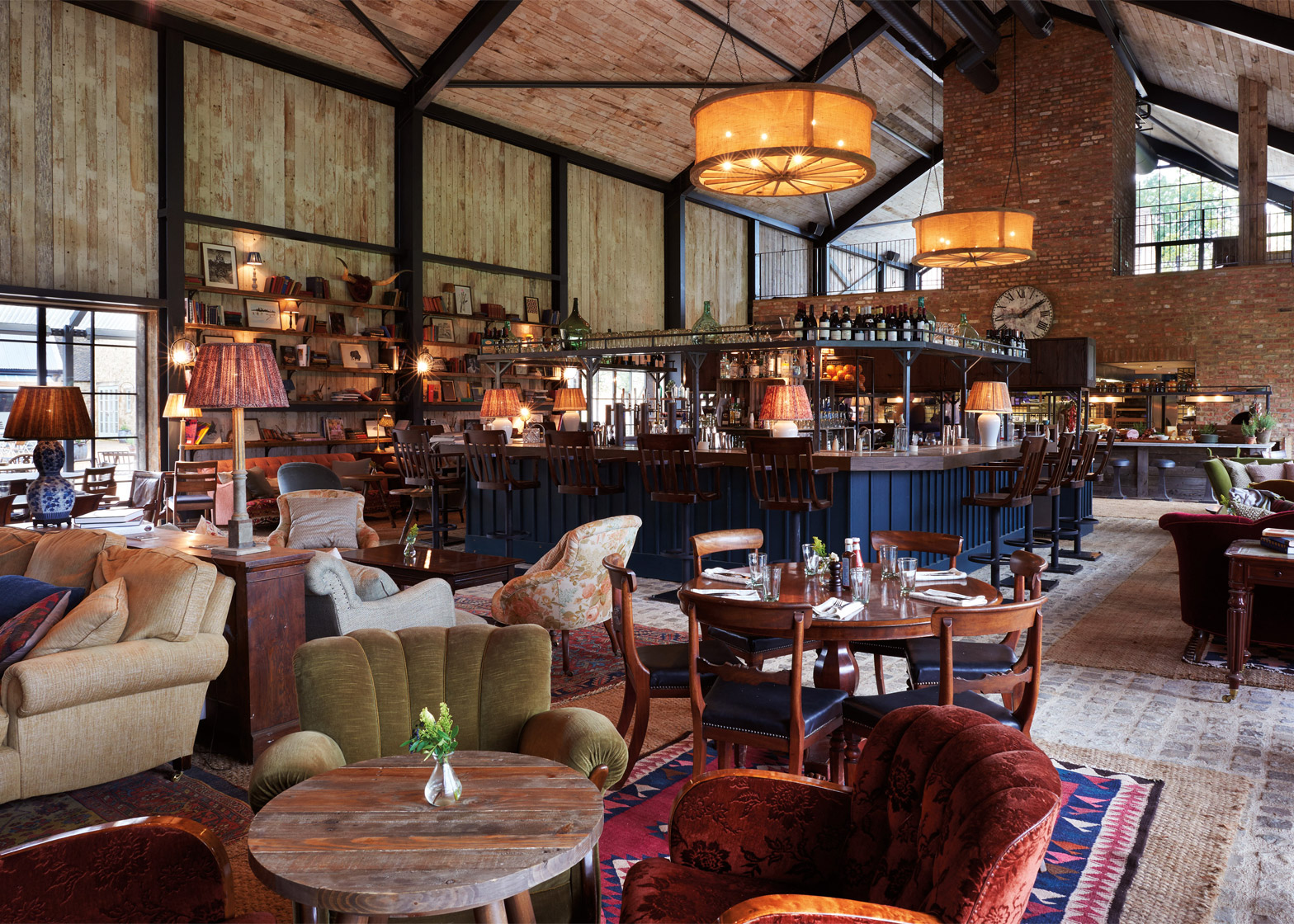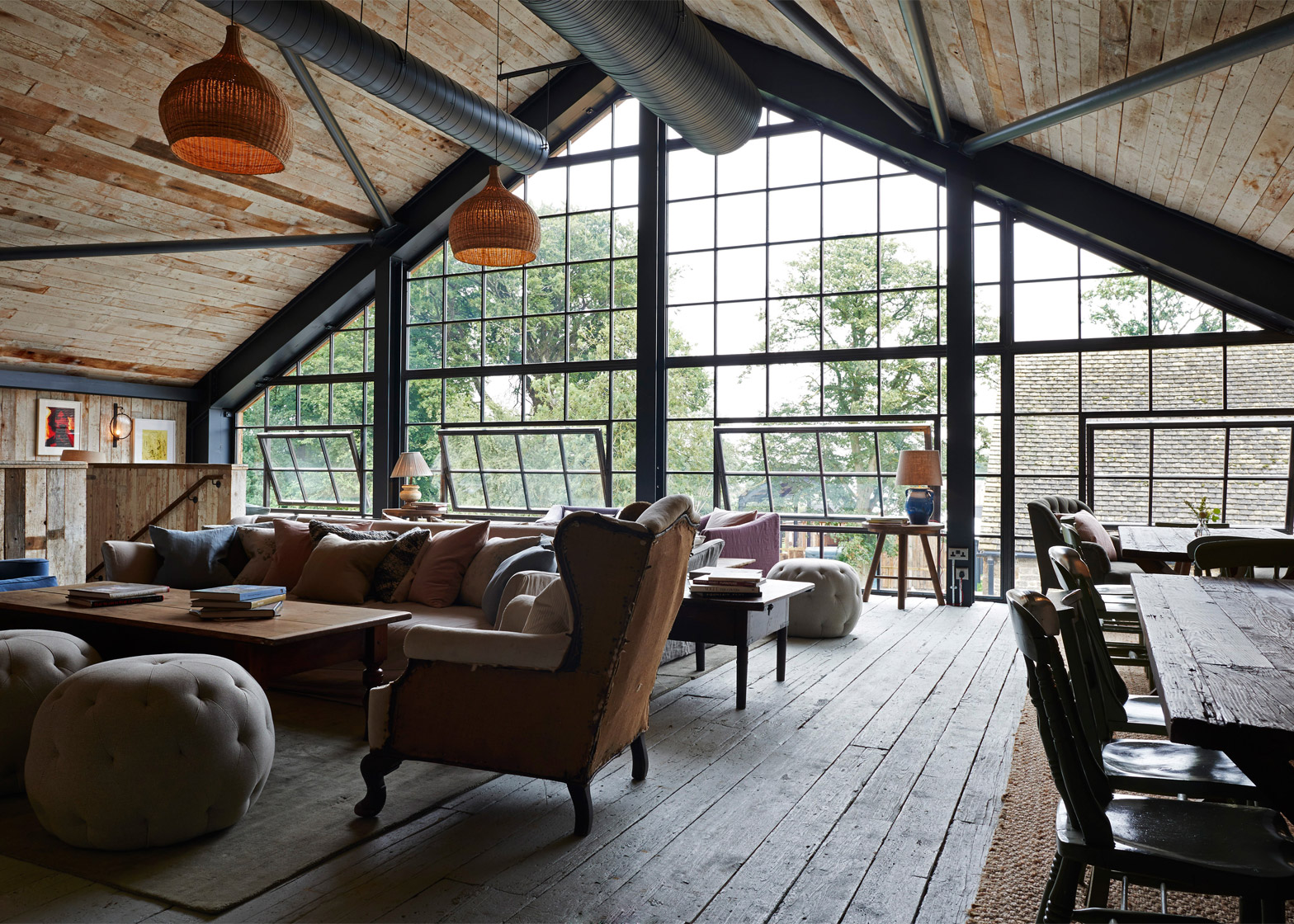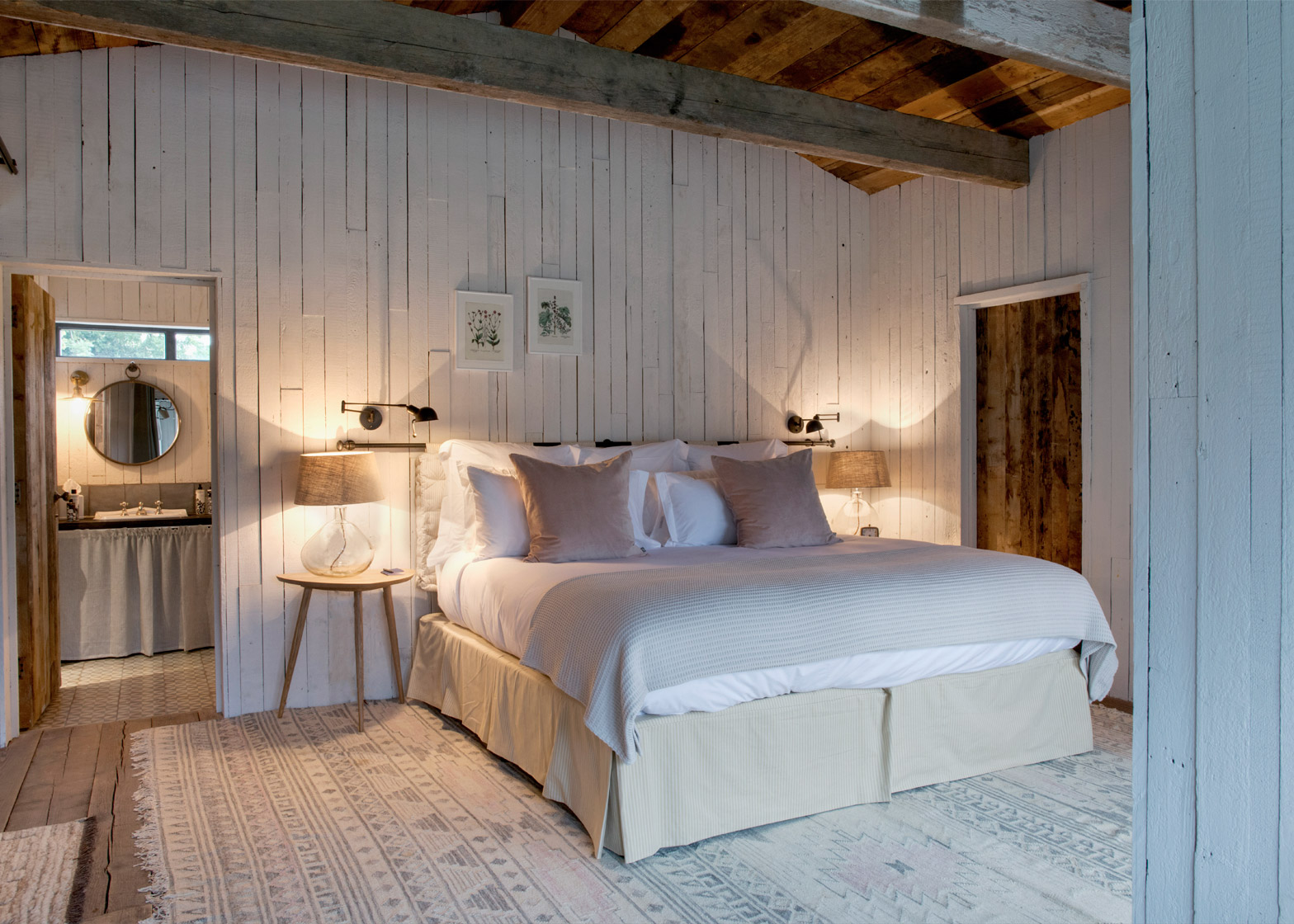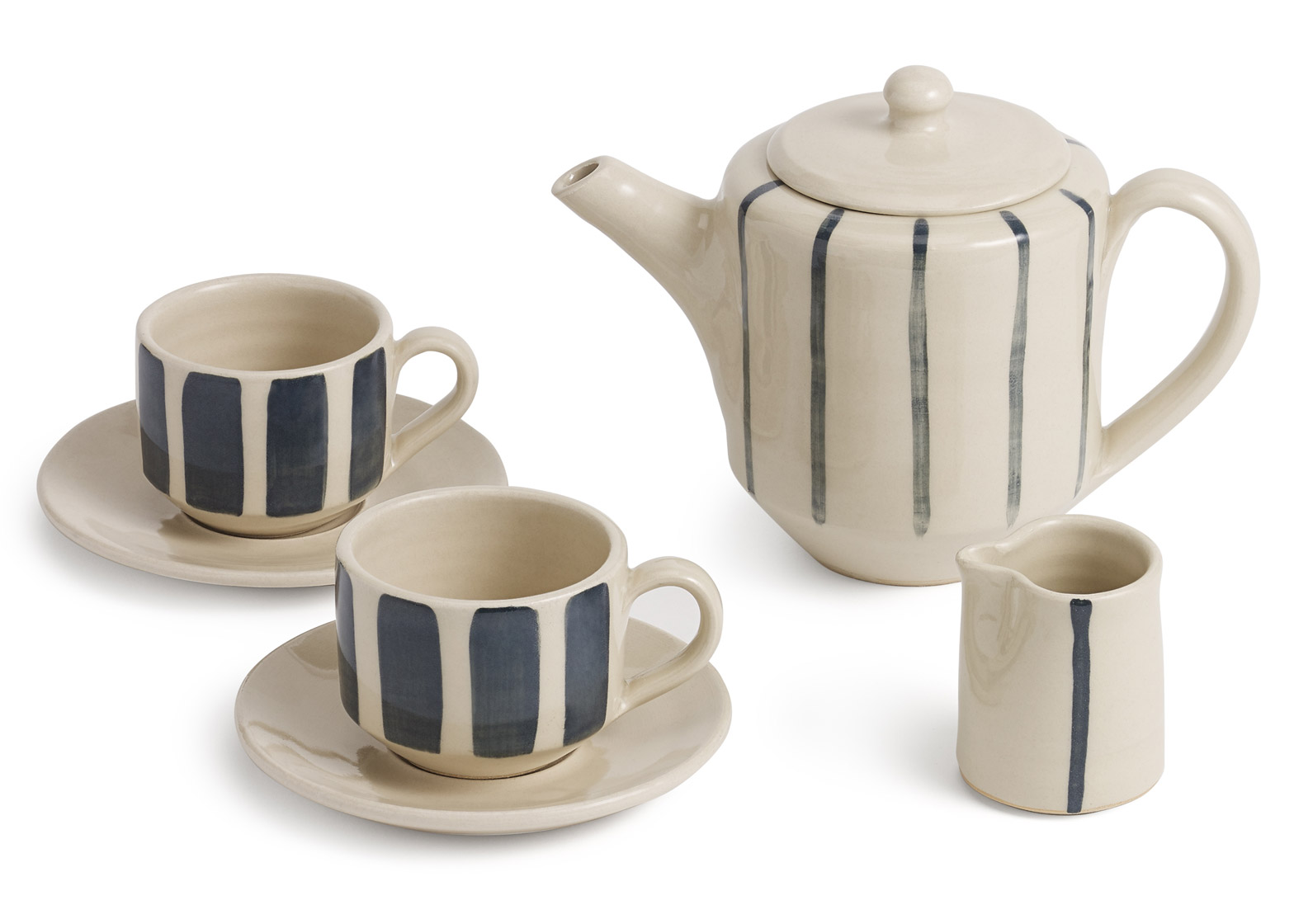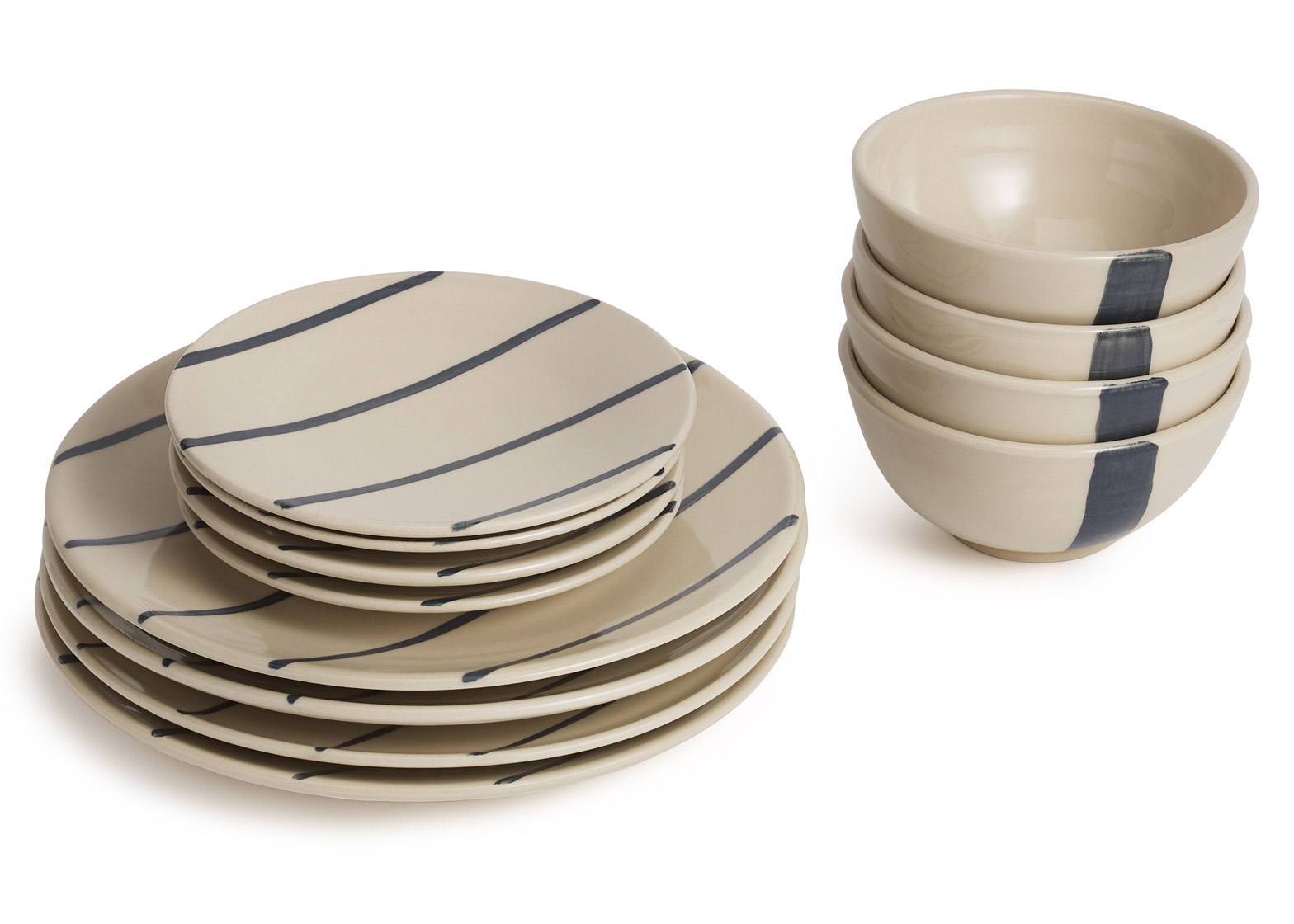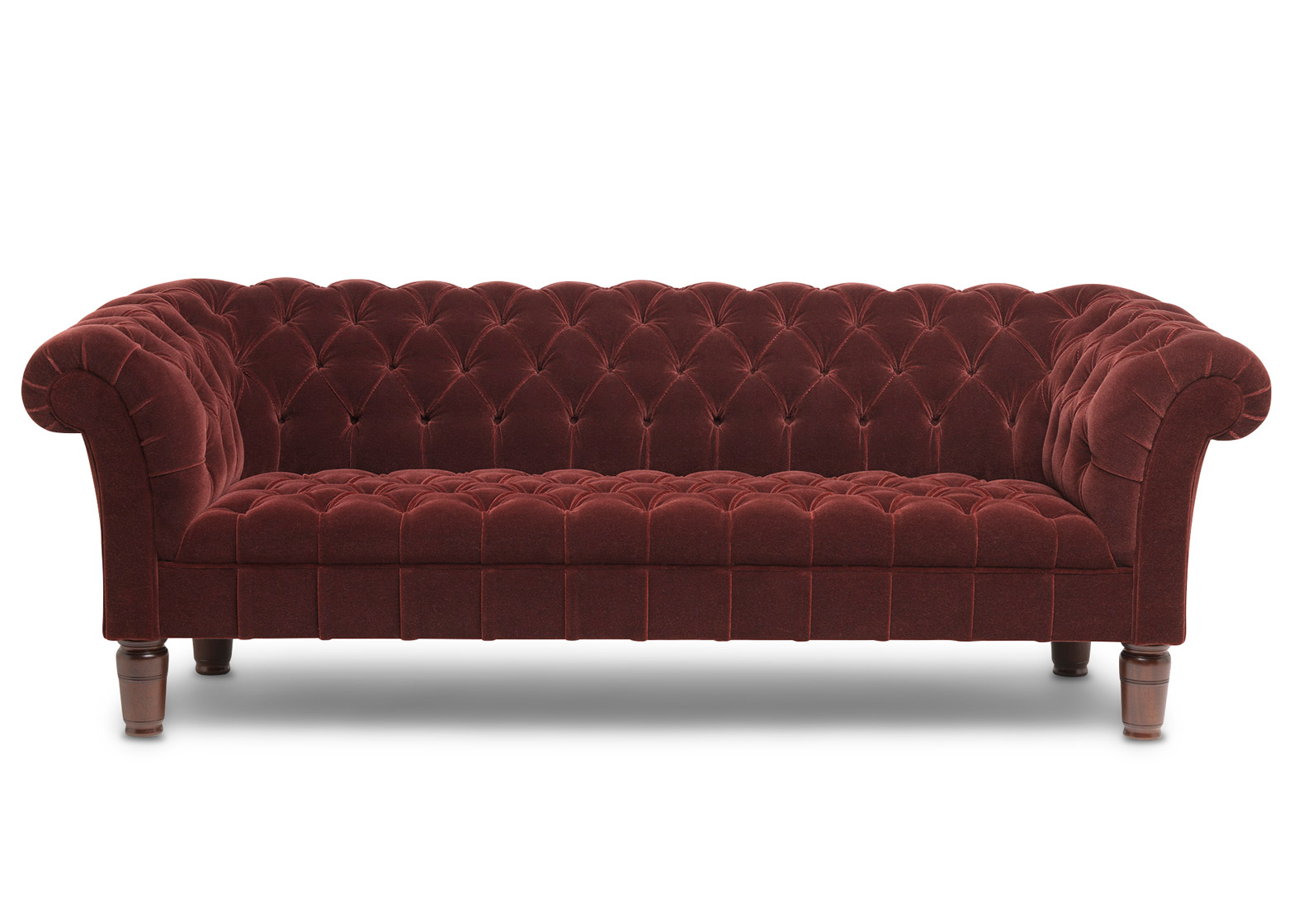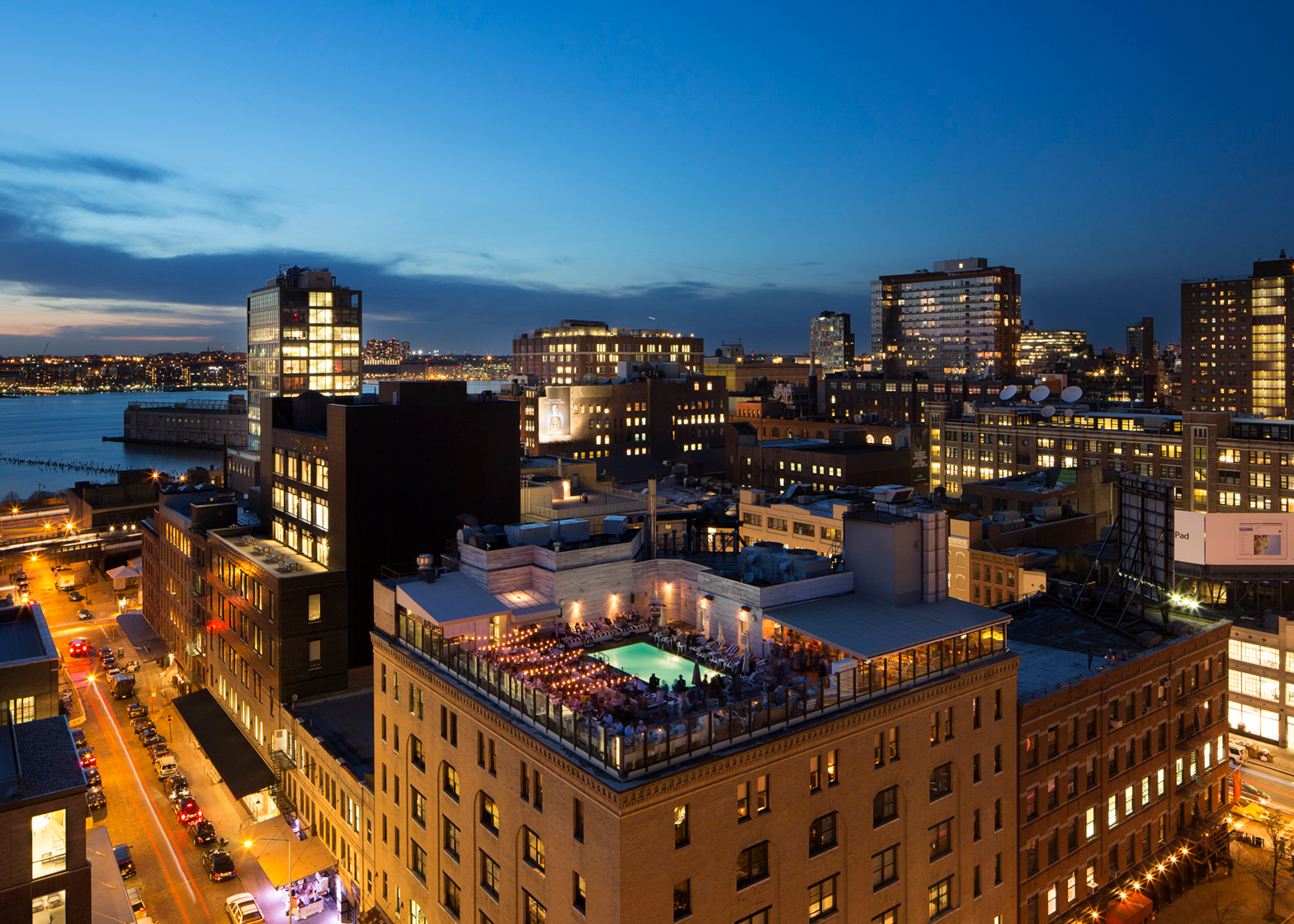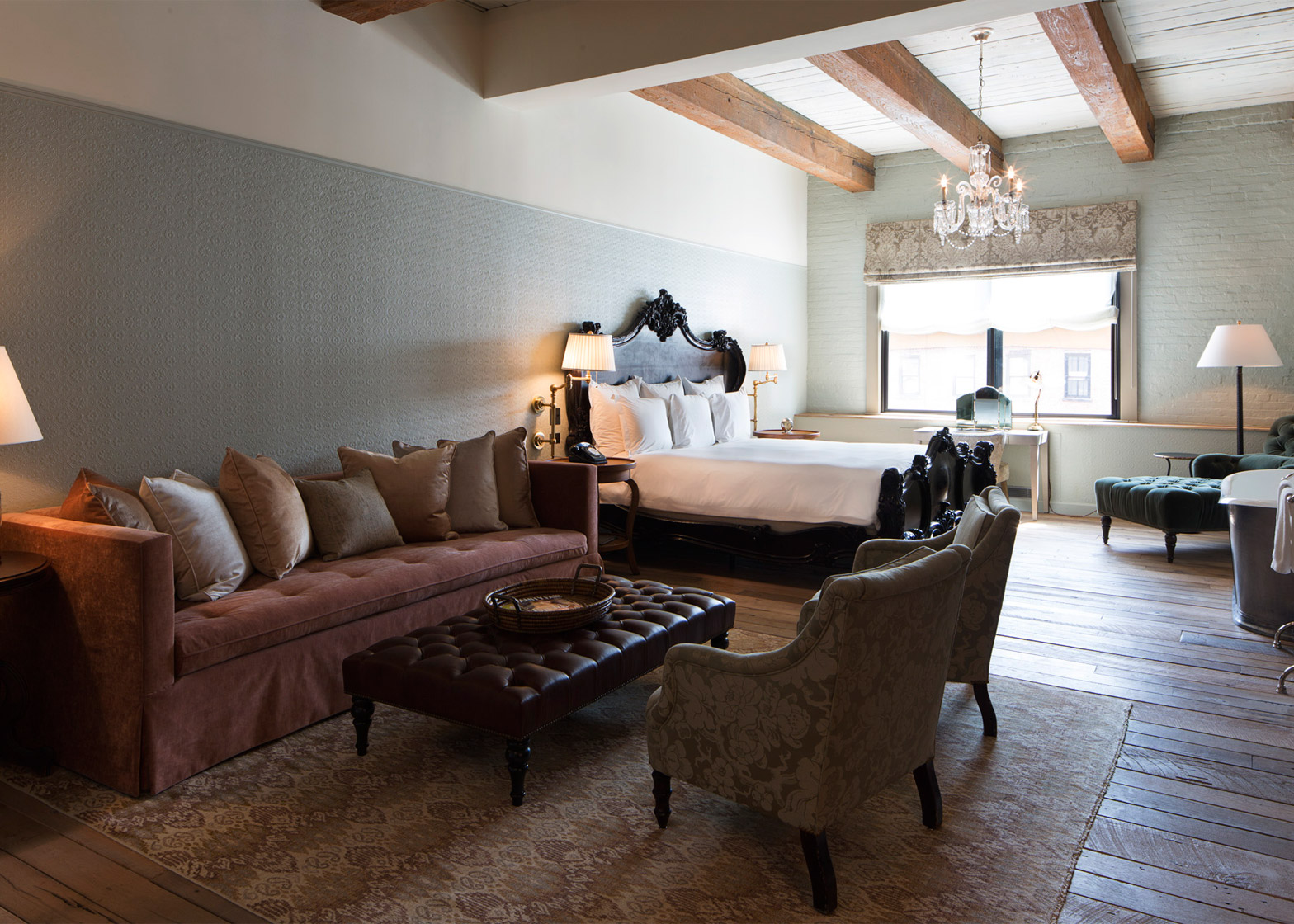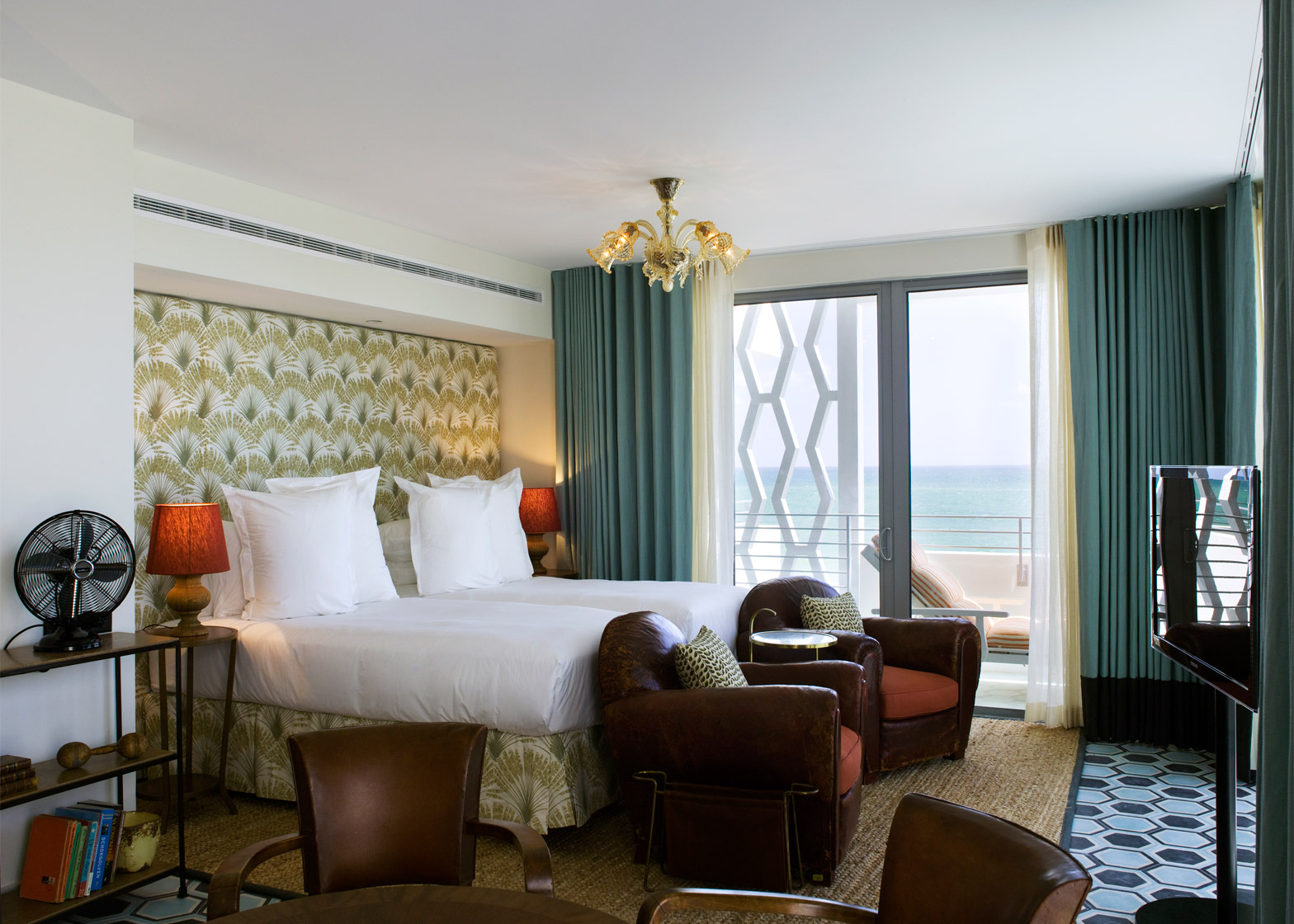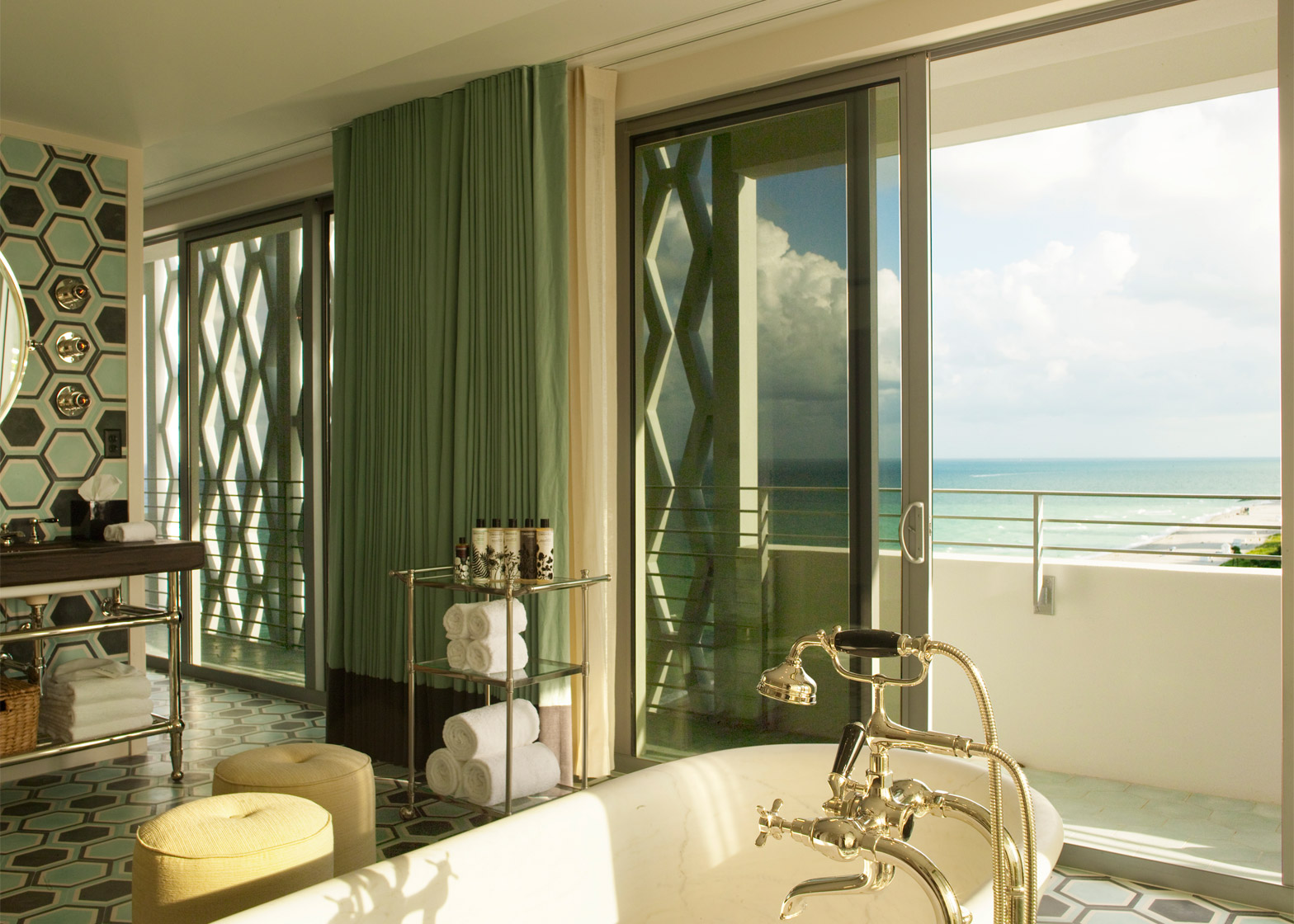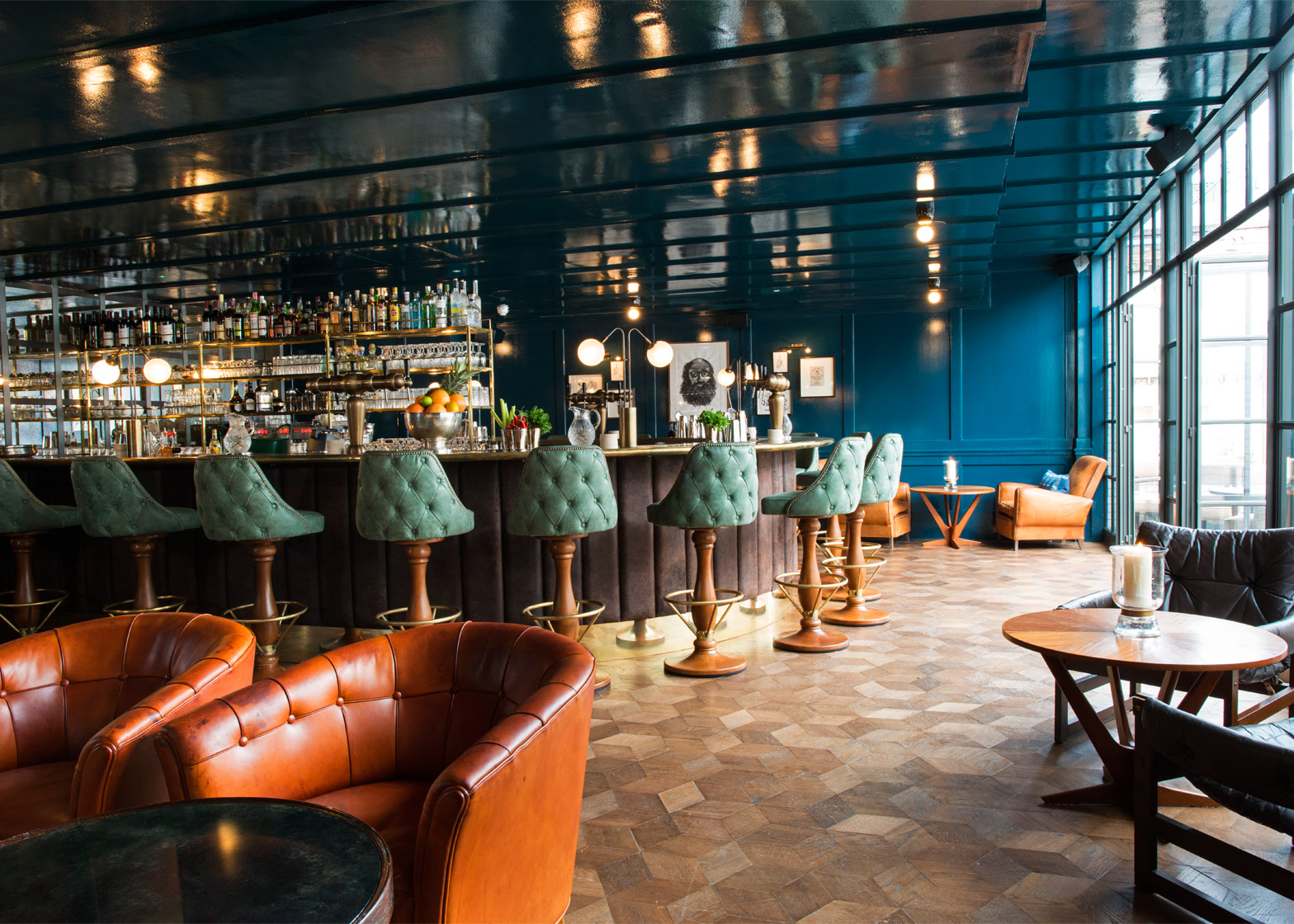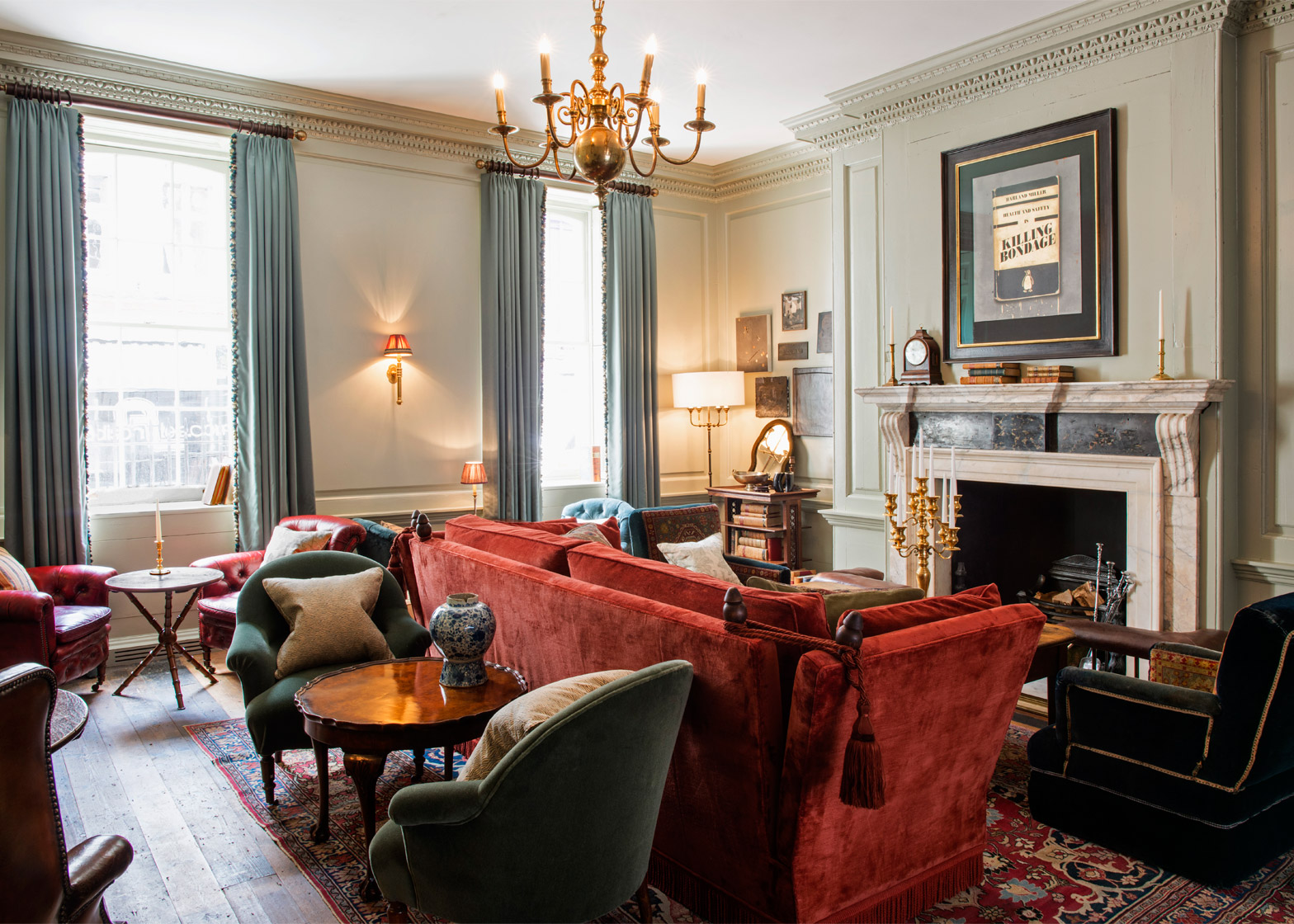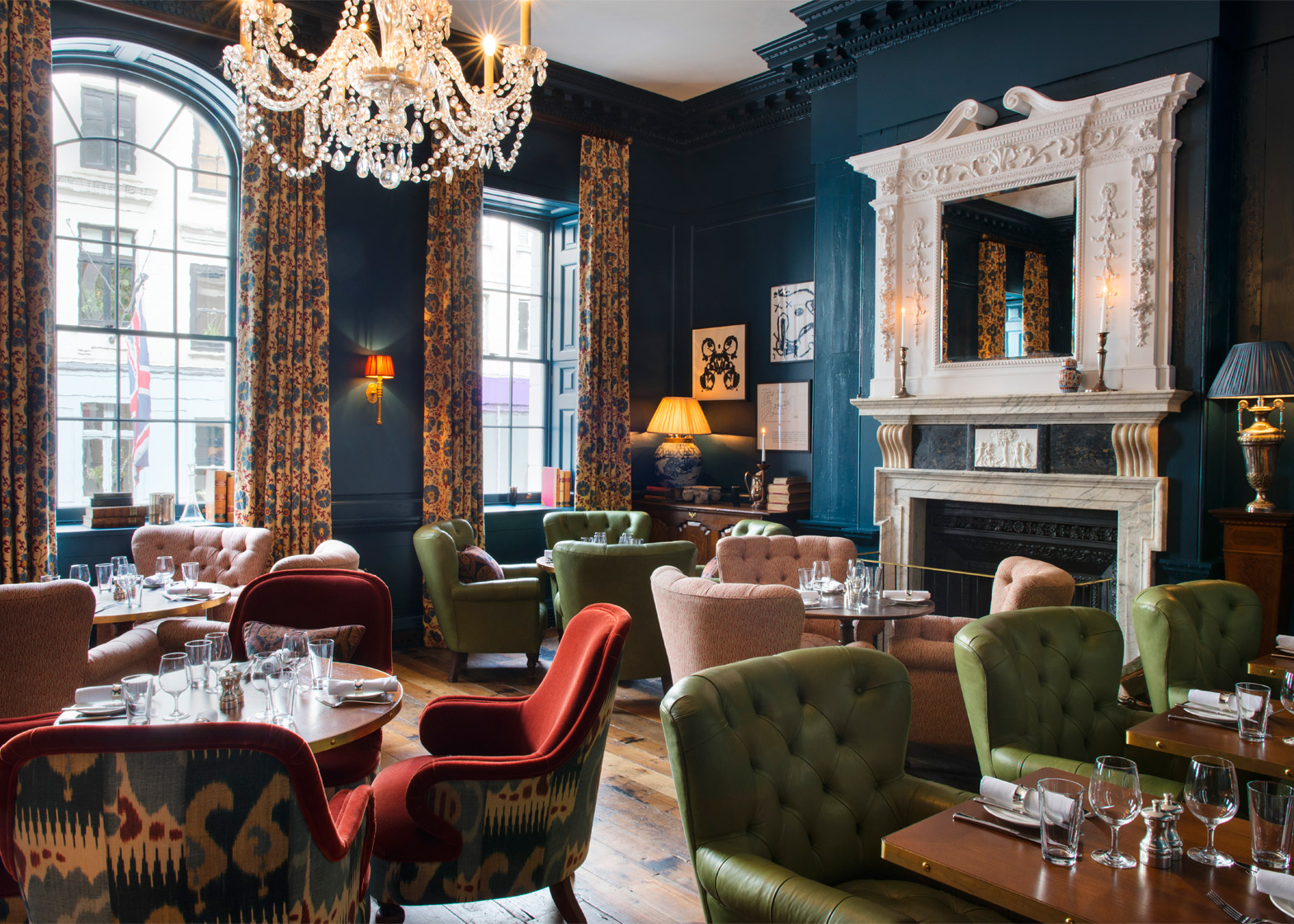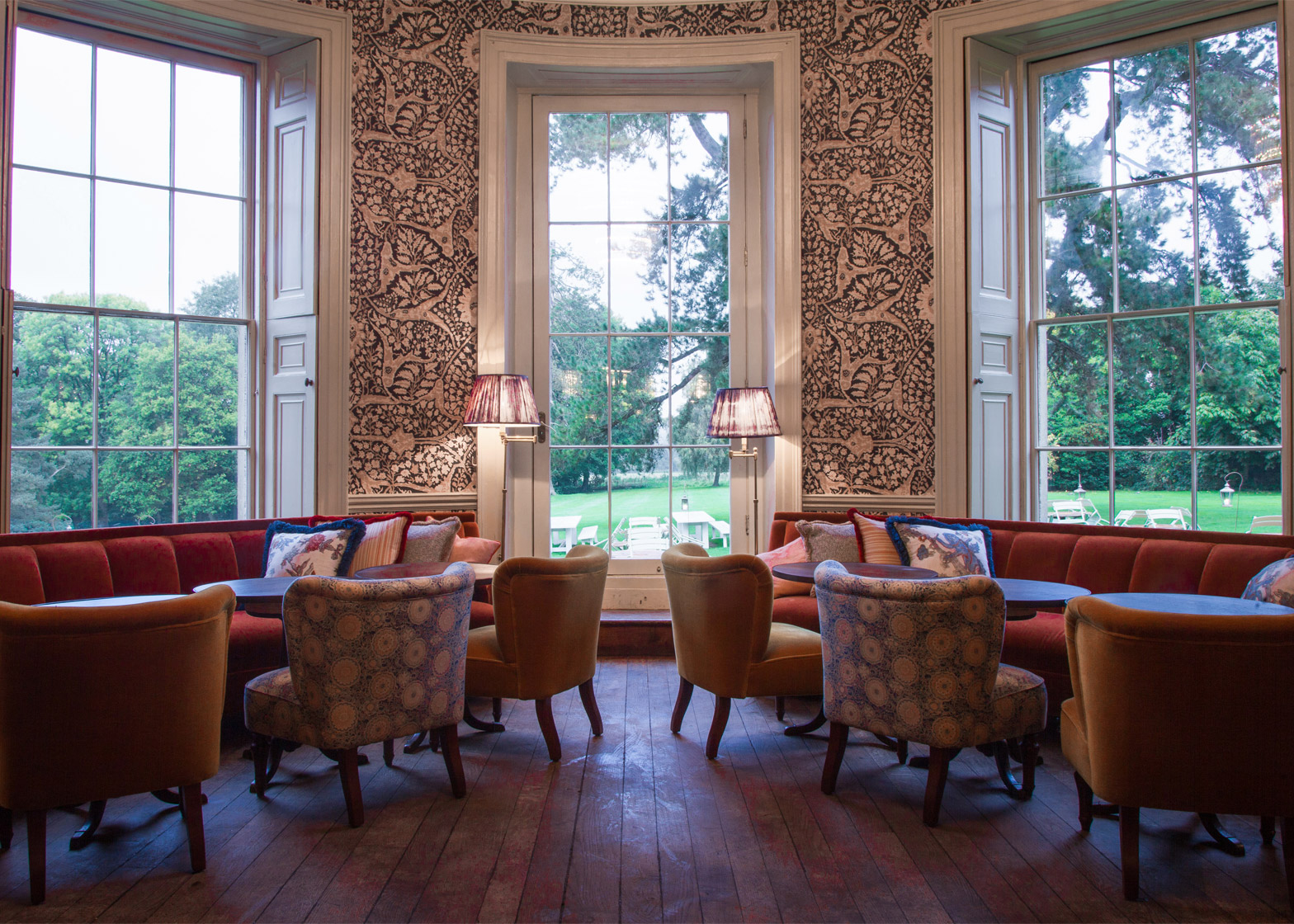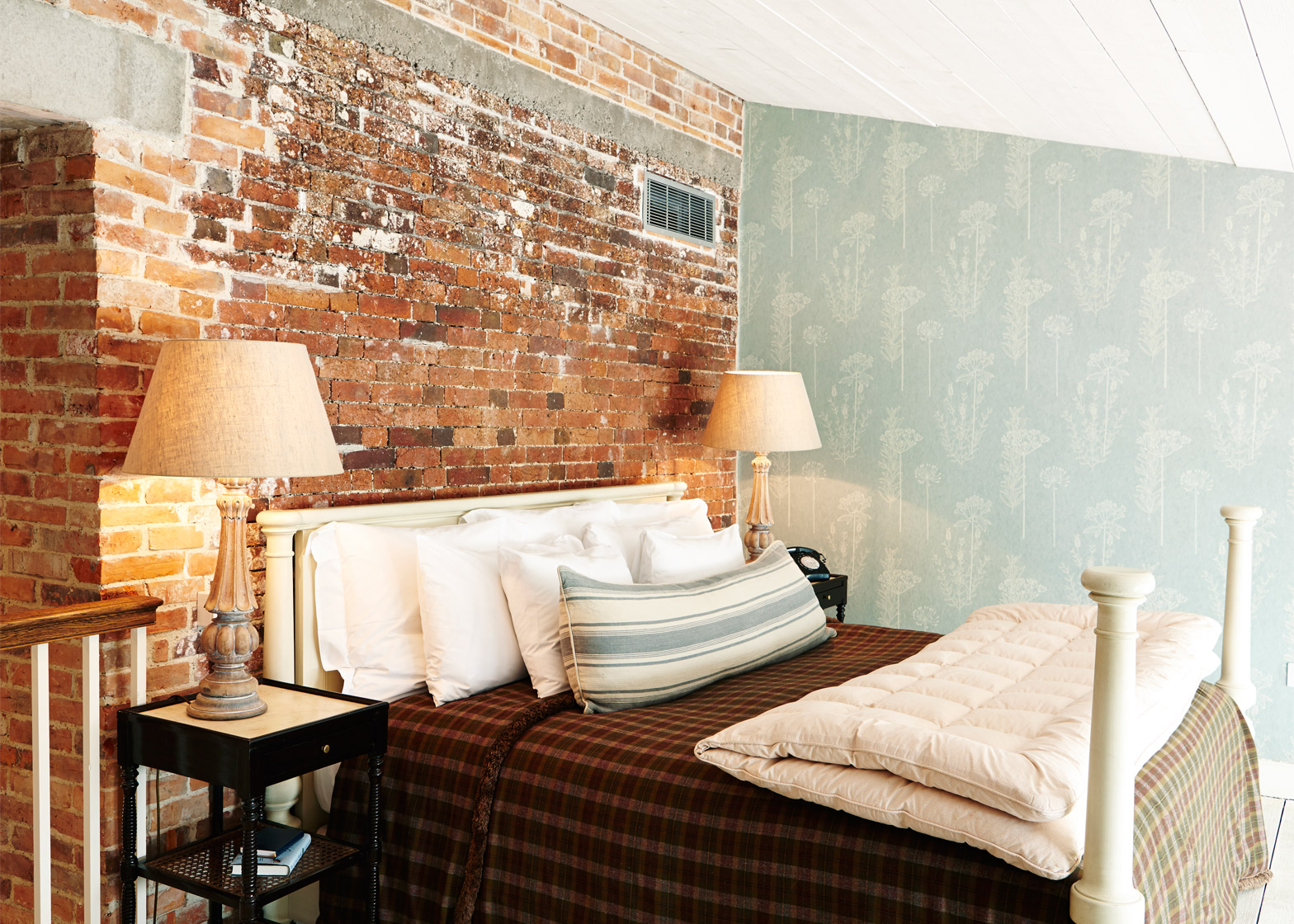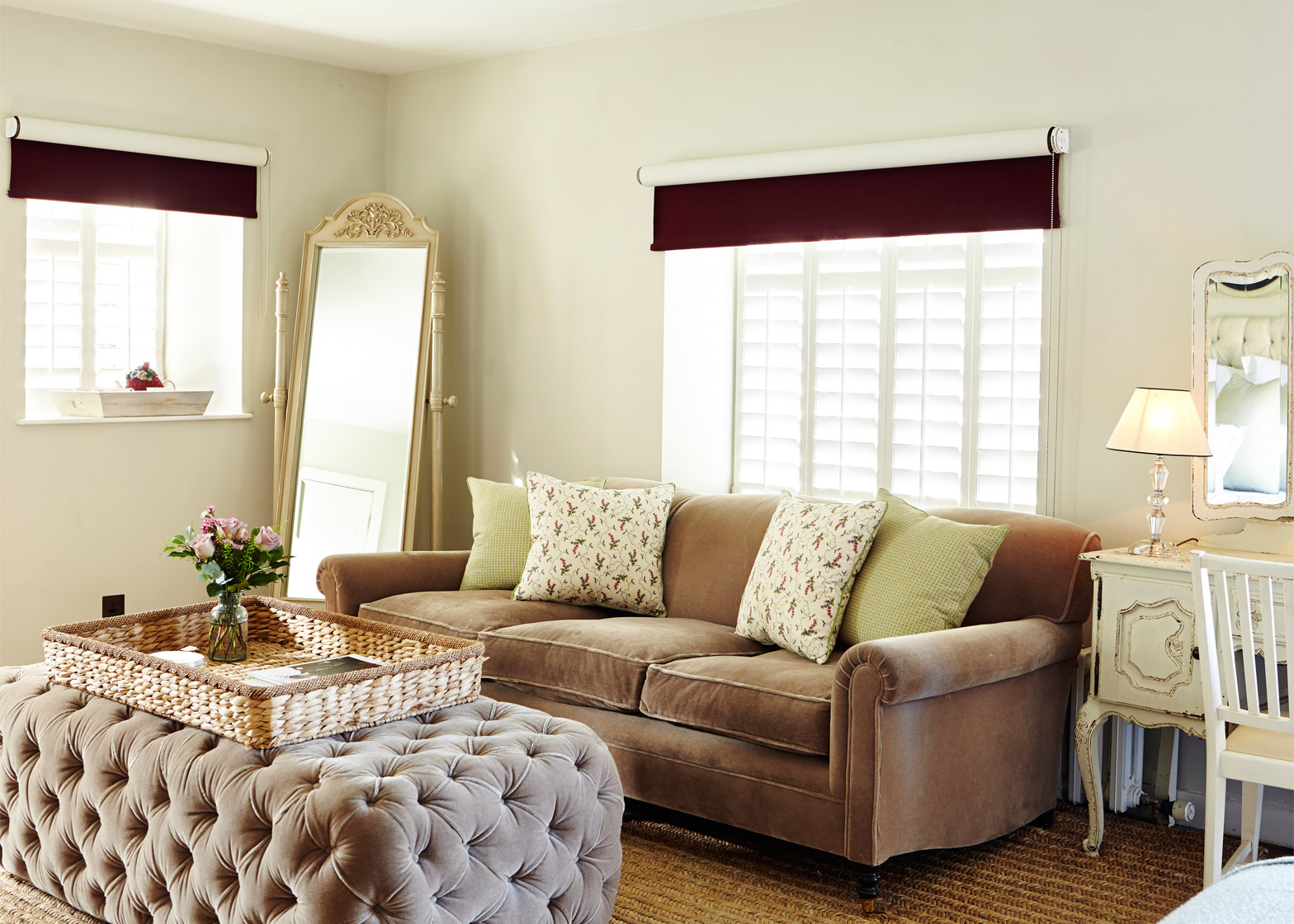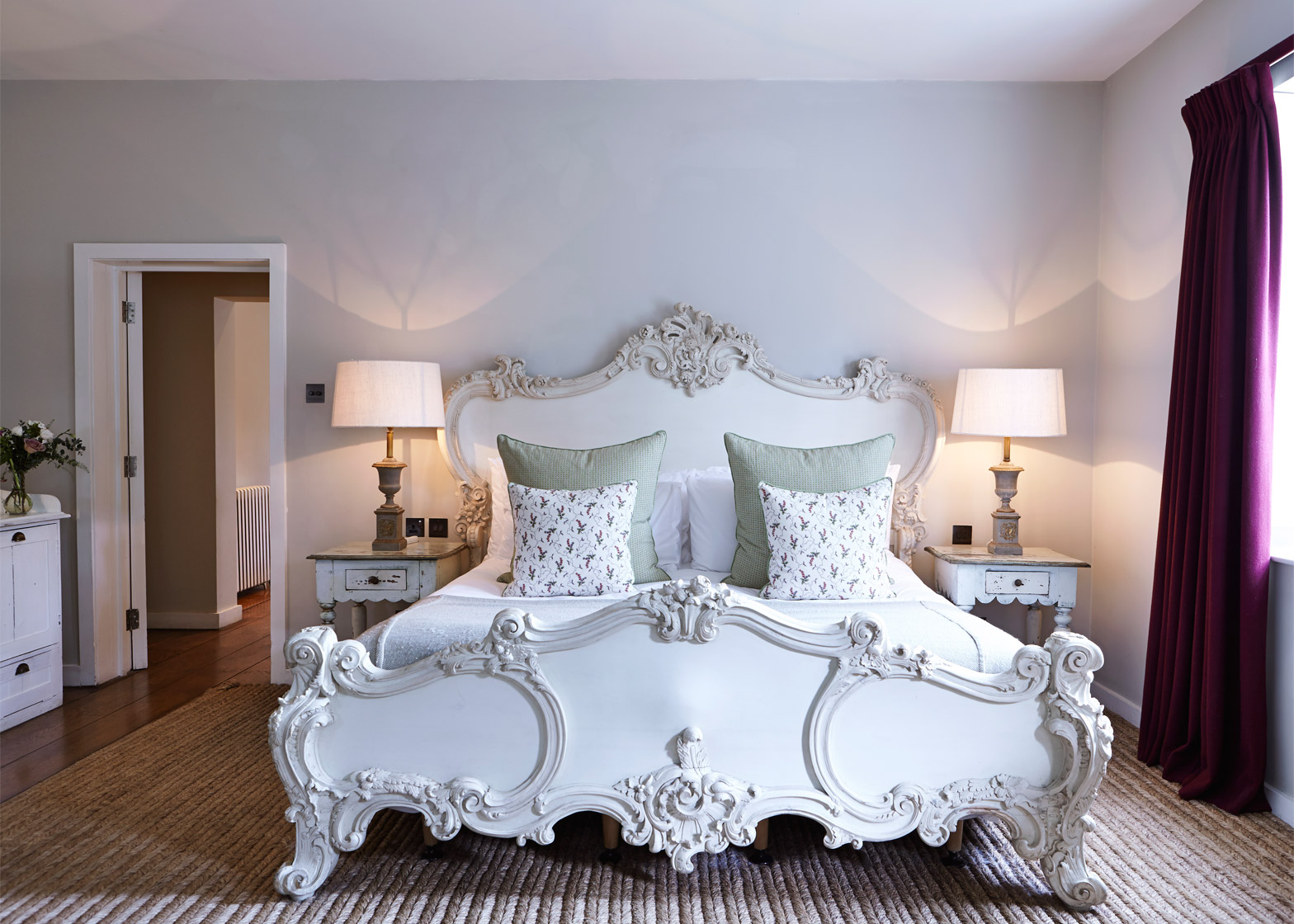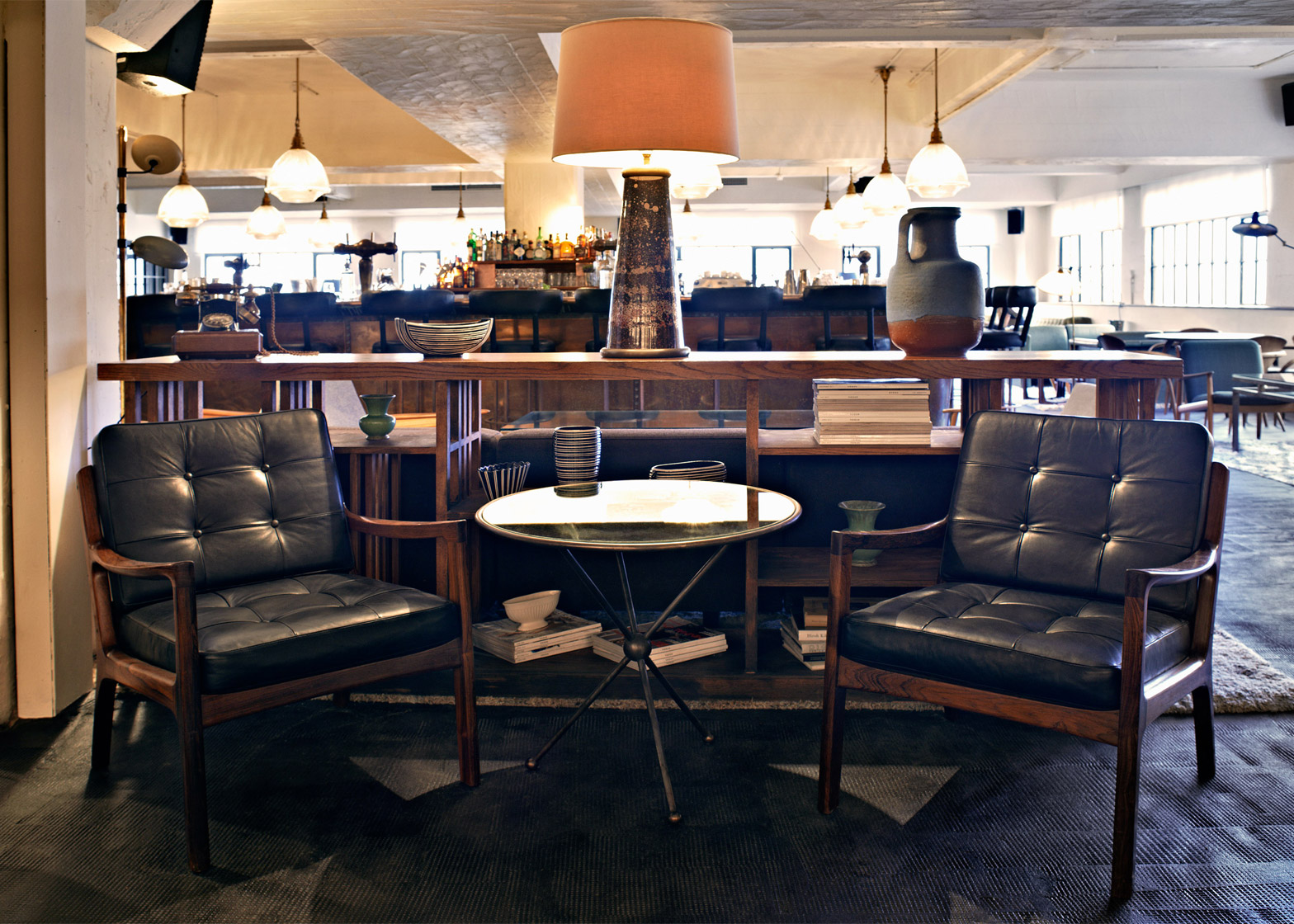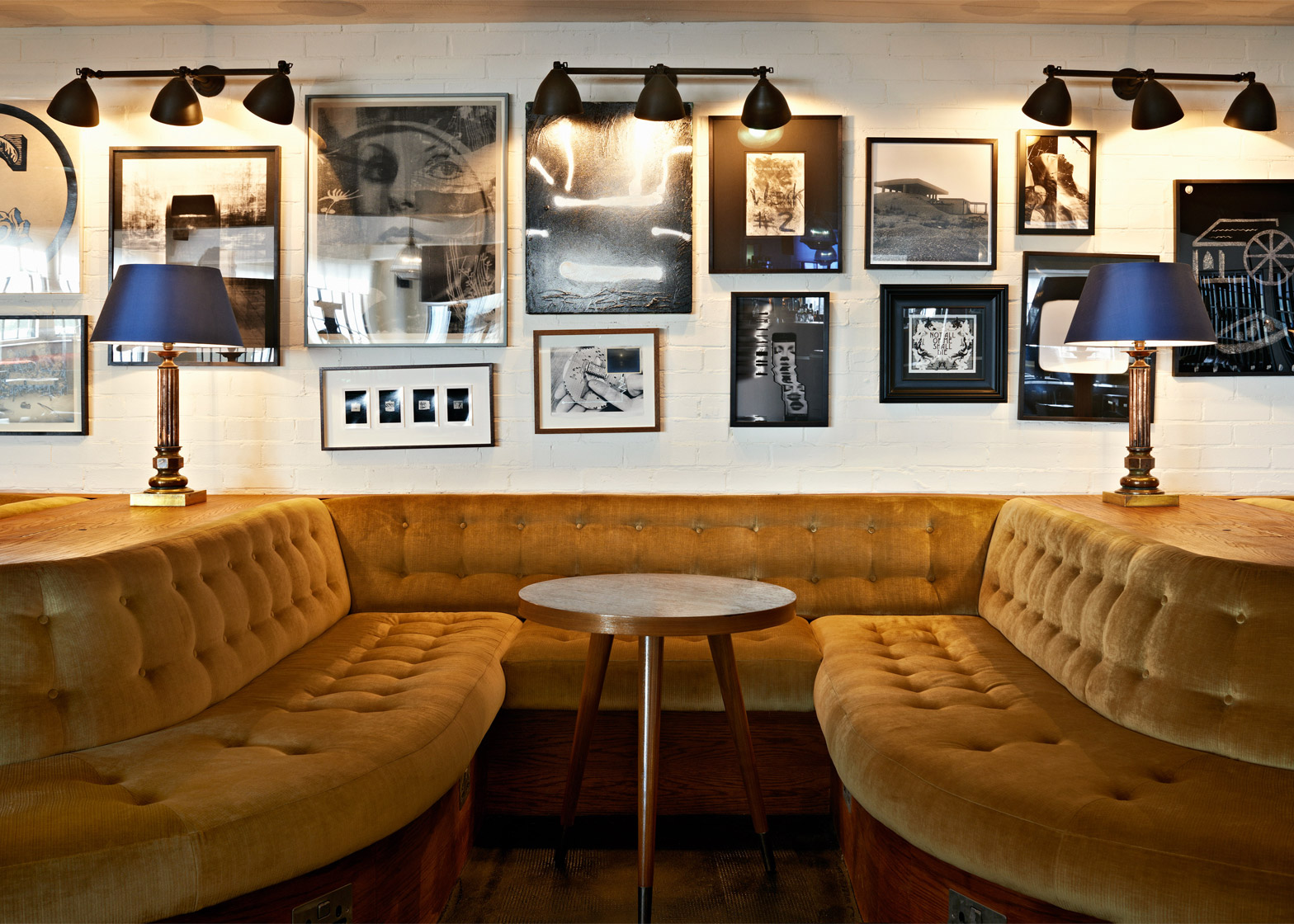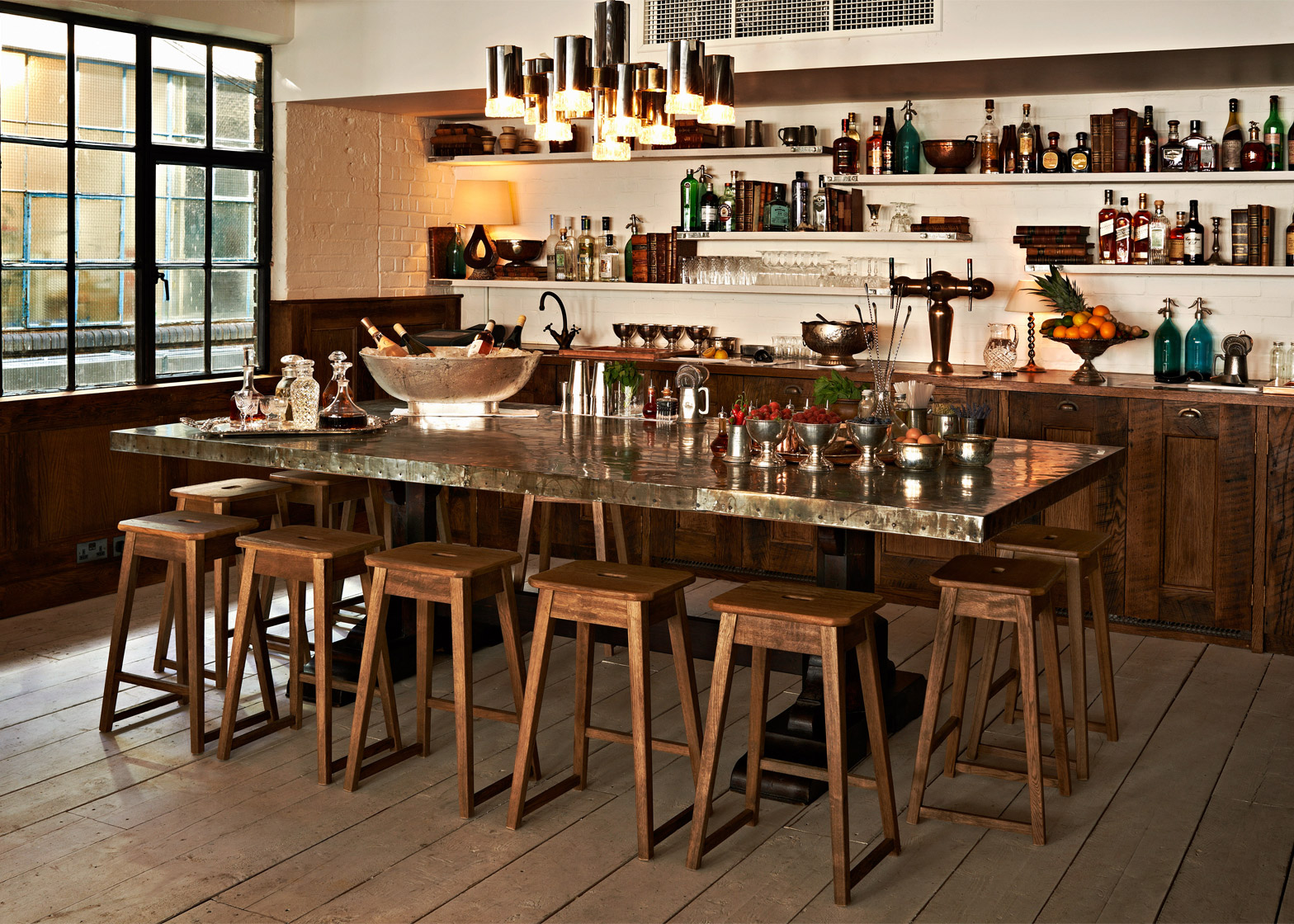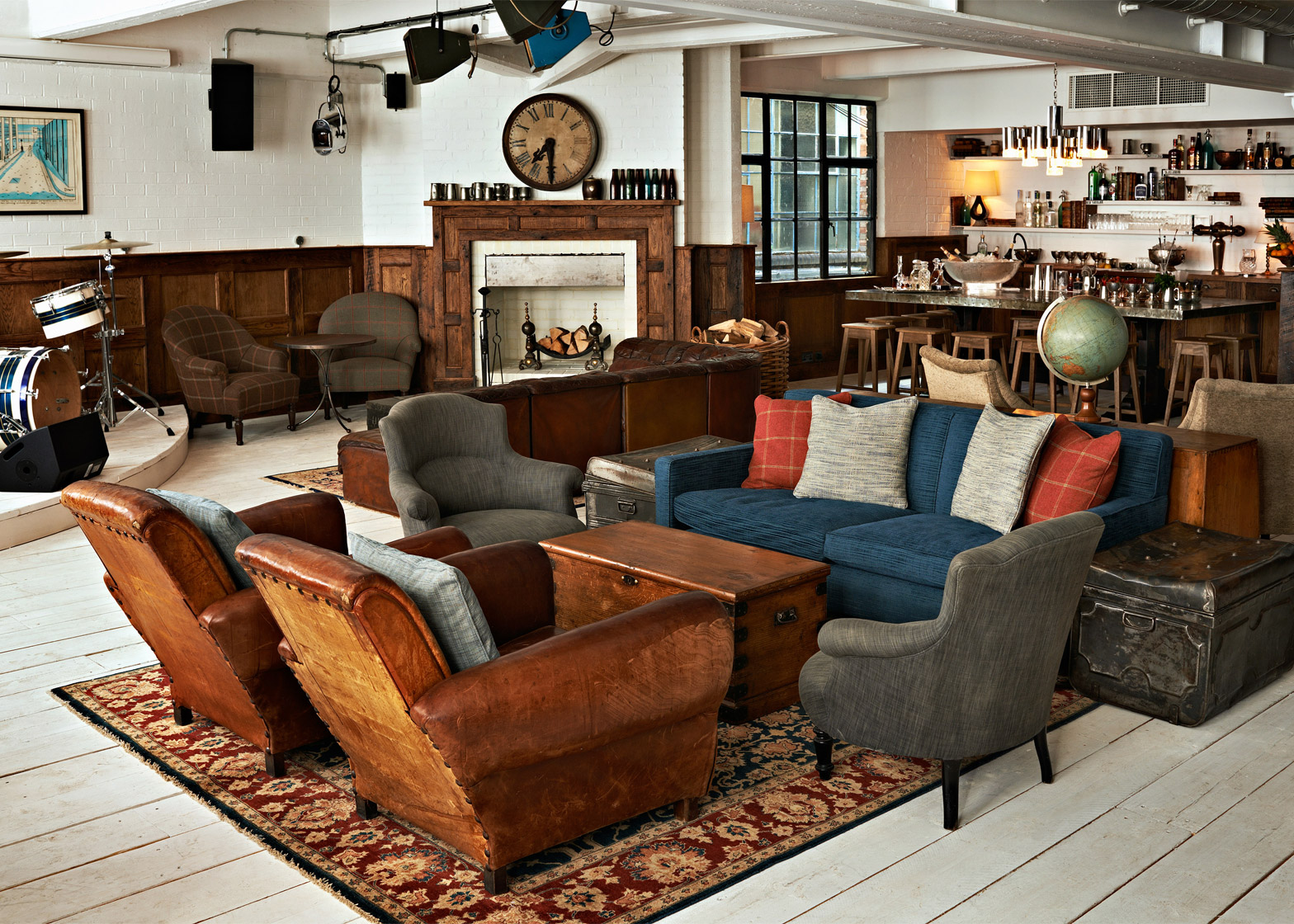Over the past 20 years, former caterer Nick Jones has built Soho House into a global empire of private members clubs, restaurants, spas and now Soho Home, an online homewares store. He sat down with Dezeen to discuss his approach to design (+ slideshow).
Jones spoke to Dezeen at Soho Farmhouse, a 100-acre farm in Oxfordshire that has been converted into a luxury resort.
The farm, which opened last year, was designed by Soho House's in-house design team in collaboration with architecture studio Michaelis Boyd. Jones brought all his design services in house four years ago, and now employs a team of 50 to 60 designers around the world to roll out the Soho House look at its ever-expanding network of properties.
"I think that, above all, it's got to be comfortable," he said, when asked to explain the brand's design approach.
"I'm constantly reminding our designers that it's not about them. It's not about a mood book, it's not about a portfolio at the end of the day; it's always about the customer, it's always about the member."
Is this a reaction to the kind of spartan, minimal design that appears on sites like Dezeen?
"I think so," he said. "When we design a place it has to feel like it has atmosphere with no one in it."
Soho House Group started in 1995 when Jones, now 52, took over a rambling house in London's Soho district and turned it into the eponymous private members club.
Today the group has 17 "houses" around the world, with outposts in cities including New York, Berlin and Istanbul and others opening in Amsterdam, Barcelona and Tokyo. It also operates an interior design service for private clients, has a shared workspace in London and is considering moving into the co-living market.
Jones' latest venture, Soho Home, will allow people to buy the furniture, furnishings and tableware they see at his properties. Launching in the UK this autumn, Jones plans to eventually expand the business to cover his international markets too.
Here is an edited transcript of the interview with Jones:
Marcus Fairs: Why are you launching Soho Home and what is it?
Nick Jones: Well the reason why we're launching Soho Home is that over many years running Soho House, members and guests, have constantly asked me: 'Where do you get the pillows? Where do you get the sheets? Where do you get the towels? Where do you get the sofas? Where do you get the mattresses?'
As we built Soho House more globally it became more and more apparent to us that we should be designing and manufacturing these items ourselves for cost-saving within the business. When we decided to do that, we thought, 'well, if we're going to do that, why don't we create a website and sell it to our members online?'
Marcus Fairs: You used to work with external designers, including Tom Dixon and Ilse Crawford. Now you've pretty much brought everything like that in-house. Explain that journey that you've been on and the way that you work with designers and architects.
Nick Jones: Well, for a long time, obviously as we were growing, we did work with brilliant designers: Ilse [Crawford, who designed Soho House in New York and Cecconi's restaurant in London among others], Martin [Brudnizki, Soho Beach House in Miami Beach], Tom [Dixon, Shoreditch House in London].
During that journey you learn a lot, but at the same time you realise that a lot of what they're doing is a lot of input from yourself anyway. It seemed like the obvious thing is to start taking design in-house and we started doing that about three or four years ago. To our surprise, designers and architects wanted to come work for us and it's grown from there. We have quite a thriving in-house design and build team.
Marcus Fairs: How many designers have you got and where are they around the world?
Nick Jones: I don't dare count how many there are because I might get it wrong. I think it's about 50 to 60, mainly based in London but we also have an office in New York and one in LA. They're working on our projects but they're also working on other people's projects.
Marcus Fairs: You've started to do private design commissions. So that's a service for individuals who want the Soho House look for their beach house or townhouse or whatever?
Nick Jones: I don't know if they necessarily want our look but they want something that we can offer. We started doing something – we call it Private House – where we are doing a few selected houses and peoples' places themselves.
Marcus Fairs: And you have a construction team as well?
Nick Jones: In the UK we have a construction team. There was no strategy, we didn't sit around a table and say we have to create our own construction team, it was more responding to an opportunity. I didn't mind which construction company I used but I minded that there was this one particular person who was running the job and that guy was called Neil Crowe.
Neil and I had been working together for about 12 years on every project, so whichever construction company he worked for he usually got the job. Therefore, he was constantly in quite a lot of demand from poaching from construction companies because they knew, with him, they got the Soho House work.
He then phoned me up one day and said, 'Nick, why can't we do this ourselves, we can't we create in-house build?' And I thought, 'why couldn't we?' So that that's reason we did that, it's more from an opportunity rather than a strategy.
Marcus Fairs: So it's almost a holistic brand now: you walk in to a Soho House property and everything is designed by Soho House, the toiletries are by Cowshed – which is your brand – even the construction was done by your guys. What would you call that? Wall to wall? Cradle to grave?!
Nick Jones: Sounds a bit awful when you say it like that. It doesn't sound like how it should sound really. We got there through just being more efficient and wanting to control the environments totally ourselves. We sit here in the farm and everything you see in the farm has been done in-house, which in one way sort of makes me proud and on the other side – as I said at the beginning – sounds a bit weird.
Marcus Fairs: Tell us how it all came about.
Nick Jones: Well I left school and I'd always wanted to go into catering, as I call it, or hospitality. It was never something I suddenly accidentally found myself in' I always wanted to be in a job where I get people to have a good time. I'm passionate about eating and drinking and so a 'house' just came about.
I had a couple of false starts on restaurants, one being over-the-top even though it's still the same company now but we did have a restaurant in Soho called Cafe Boheme, which has been there for about 25 years. It's being refurbished now. The offices above it became available and the landlord phoned me up and said, 'well Nick, how about it? How about taking the space above?'
Marcus Fairs: The landlord was [porn publisher and strip-club owner] Paul Raymond right?
Nick Jones: That was Paul Raymond. And I went, 'Uh, okay.' There only happened to be a small door. It was a great space because it's three houses over three floors – consequently that's how our logo [a grid of three squares by three squares] was created. I looked at the space and thought, 'it can't a public restaurant because it's just a small door, so how about a private members' club?' It was three houses in Soho, so that's how Soho House started.
Marcus Fairs: And you've now rolled that out around the world. Tell us how many of the houses you have and about the expansion, and also what's the design approach to each of these diverse locations.
Nick Jones: Well, I think currently we've got about 17 houses and we have three under construction at the moment. The design approach is totally sympathetic to the building and the city. Whenever we go into a city we are guests in that city, we don't feel that we have any right to be successful or any right to be wanted. So it's very important to us that we integrate ourselves in to the culture of that city.
The design and the feel of the place comes from that. But obviously we want to make sure that there's a streak of the Soho House feel wherever we go.
Marcus Fairs: And what would you say that feel is? When you were talking about Soho Home yesterday you were saying that there's always a bit of vintage and there's always a bit of your own products. What would you describe the Soho House look?
Nick Jones: Well I think that, above all, it's got to be comfortable. I'm constantly reminding our designers that it's not about them. It's not about a mood book, it's not about a portfolio at the end of the day; it's always about the customer, it's always about the member.
Marcus Fairs: Does that mean in some ways it's sort of a reaction against that clinical modern look that Dezeen likes to publish, but which can sometimes be a bit echoey and soulless?
Nick Jones: I think so. When we design a place it has to feel like it has atmosphere with no one in it. Then when you actually fill it up with people, that is when it feels fantastic. I walk in to the main bar here at the farm today and it feels great with no one in it, but it feels fantastic when it's full of people. Design goes wrong sometimes when it only feels good when it's full of people. The poor first person or middle person is going to have a bit of a rough time.
Marcus Fairs: What kind of people come to Soho House? How would you describe them?
Nick Jones: We're not one of the typical private members clubs in that none of our members is moneyed, you know? We much prefer what they are like as a person. They have a creative soul and a like-minded way about them, that's the sort of member that we like.
Marcus Fairs: Now you've gone global – and of course creativity has gone global, business has gone global. Have members changed, do they want different things now?
Nick Jones: I think a lot of things have changed with how people work, how people relax, how people take their time out. I think it's a lot less structured than it used to be. The young don't want to work with big corporations. There's many more startups, there's much more entrepreneurial spirit around than there was probably when I was going into the workplace.
I think that has all sorts of effects on how people go out and play and socialise, etc. Today I think it's a lot better than when I was doing it. It seems a lot more organic, more fun. I think if you did have an ambition, people back in my time were very afraid of doing it on their own. Now doing a startup is almost like getting a coffee.
Marcus Fairs: Has that changed the way that people use the houses? Has it become equally about work as it has about leisure, or has it always been like that? You see people with laptops everywhere now.
Nick Jones: You do see a lot of laptops; I don't know quite what they're doing on the laptops. I think people have their laptops up because they want to look relevant and busy but they might be using Facebook.
Marcus Fairs: Are the houses somewhere where people go to relax and socialise, or where people go to work?
Nick Jones: It's funny you mention that. Yes, people go and work there, they use it as a space to work, but at the same time we're beginning in the houses to ask people to put the laptop away at a certain time. I think there is a time where you say, 'come on guys, haven't you done enough of that today?'
Marcus Fairs: A certain point in the evening is it, or what?
Nick Jones: In certain rooms, in certain places, we say, 'come on, can you pop that away now? Grab a drink and talk to someone.'
Marcus Fairs: Yeah, I was at 76 Dean Street a couple of weeks ago and I was waiting for my lunch appointment to arrive. I was asked to put my laptop away. I wasn't aware of that rule.
Nick Jones: We just don't want to be taken over by Apple.
Marcus Fairs: Speaking of which, you have now ventured in to the workspace world, with Soho Works in Shoreditch. Is that so members can have somewhere to go to work?
Nick Jones: This community's working ways are becoming more and more apparent everywhere and we felt that we wanted to give that opportunity to our members. We thought we would do our own version of it. So that's why Soho Works was created, it was really from the demand of our members, to give them an option if they did really need a proper regular space to work from where they can have their laptop out all the time.
Marcus Fairs: As long as I've been a member you've always had a no-mobile-phones rule. Is that for the same reason as banning laptops?
Nick Jones: I think so. People on phones are not very nice for everyone else. I always find, when I'm on the train and someone is on a mobile phone, I'm involved in the phone call as well, even if you don't want to be involved in the phone call. We don't mind people using their mobile phones but we don't want people really talking into them. We don't want to hear other people's business. It is to do with that as well.
Marcus Fairs: You mentioned yesterday that you're looking into co-living as well.
Nick Jones: Yeah, we're looking. This whole space where people want to work together rather than at the kitchen table or in the Starbucks or in the Soho House; where they want to have a community, a communal workspace: I think that is definitely moving over to living space as well.
People, certainly over the last 10 years, they date online, they talk online, they do everything online. When we were kids we did it differently. If we wanted to talk to a girl we had to pluck up the courage to go talk to her in a bar or at a party. Now it's all done online, I think it's reverting back. Somehow people want to be part of communal spaces where they do have to have conversations and they do have to have those awkward moments.
Marcus Fairs: You say you're looking in to it. Are you exploring it? You mentioned that it would be called Soho Living.
Nick Jones: It's not something we're actively looking at. We're looking at the possibility of moving to, as you said it, an upgraded student-living idea. You know for people that come out of university, people who are doing startups, accommodation can be incredibly expensive in London and if we can find places in non-expensive areas but do it in a certain style in a certain sort of way then we think there might be a good following for that.
Marcus Fairs: Back to Soho Home again. You said just now that your members aren't moneyed. So what's the pitch with the products? You mentioned they have to be affordable. What distinguishes a Soho Home product from anything else?
Nick Jones: I've said a few times that we're creating a certain way of living and it's not to everyone's tastes and it's not what everyone needs, but we feel that the look that we put across is, I think, unpretentious. I'd like to think there's a certain amount of style there, it's certainly reasonably priced.
The same member who might want to join one of our clubs is the person who might want to come to one of our Chicken Shops or Dirty Burgers or have a treatment at the Cowshed spa in Primrose Hill or stay in one of our hotels. It's that same sort of person.
It's not flashy, it's not 'ooh look at me,' it's has a sort of understated, quality feel about it and that is what we're putting in to our home range. It's what we feel that people might want to have at home and it's an edited version. You can go into John Lewis or you can go onto other websites and it's not an edited version, there's just a lot of it. I think when people come to the Soho Home website, they'll go, 'well, these guys are using it in their houses.' It's edited. It's got that feel. If I want that feeling in my house then I can buy it now as well.
Marcus Fairs: Where will people come across the brand? Will people literally walk into a Soho House and see a chair, and there'll be a price tag on it and instructions how to buy it?
Nick Jones: It's not every bit of furniture. This is probably irrelevant to this, but it's quite funny for me because I never sell. Our philosophy is always under-sell and over-deliver. That is what it's all about. We want to subtly tell people this is available. We want to point them in the right direction, but we don't want to bug people about it.
Marcus Fairs: So how will you get the turnover you need then? Ecommerce is a tough game.
Nick Jones: It's not easy. We've got a number of things. In September we launch to non-members as well as already to members, so if they want to know about us they'll sign up to know about us, but we're not going to bug people who don't want to know about us.
It's a risky strategy… in fact it's not even a strategy, that's far too much of a grown-up word. We'll just see how it goes. I do believe that people are very bright in their own minds and they'll work it out, they'll find out that we're doing this.
Marcus Fairs: Tell us how the products have been developed. You're not designing things from scratch; I understand you're working with people who are already in the upholstery game or the pottery game and collaborating with them.
Nick Jones: It's a mixture. It's a mixture of designing from scratch – developing a sofa ourselves – and working with the likes of [home furnishings brand] George Smith, or [pottery brand] Burleigh on china. It's a mixture of both. People thankfully want to work with us and they want to collaborate on some ranges. At the same time we have our own ideas on what we want to do. This is an edited version of what we think people want at home.
Marcus Fairs: Back to the houses, quickly: which are the cities that are most successful? Which are the most buzzing creative cities at the moment?
Nick Jones: Well, New York has always been very kind to us and we just opened Ludlow House, our second house in New York. So New York, London, LA, Berlin; they're big creative hubs. London is our biggest focus at the moment because Soho Home is going to be launched just in the UK because logistically we can do that. As soon as we've worked out logistically how to do it in the UK we'll expand it to the rest of the world.
Marcus Fairs: What about further east. Have you opened in China for example?
Nick Jones: We're on the verge of signing Hong Kong and Tokyo. Tadao Ando, the famous Japanese architect, is designing a building for Tokyo.
At this point Jones calls over architect Alex Jackson, director of in-house design and build at Soho House Group.
Alex Jackson: It was designed as an art gallery and residential and it's kind of morphing in to a club.
Marcus Fairs: So how does that work with what you said earlier about not working with external designers so much?
Nick Jones: Well I think that's different, because it's a complete design and feel that we're looking for in Tokyo. We'll do the interiors, we don't want his concrete sofas.
Marcus Fairs: So tell me about the Tokyo proposition then, is that going to be like a Tokyo version of what we have in London?
Nick Jones: It's 27,000 square feet.
Alex Jackson: It looks like it's a cast-concrete building, it looks like a Tadao Ando building, but we've got to try and make it feel a bit like a home inside.
Marcus Fairs: So you didn't feel like you could do a lofty-style thing in Tokyo? You had to go for a pristine concrete building.
Nick Jones: We've been offered a building which is just like the one we have in West Hollywood: a roof, lovely views, we could put a pool on it. But you sort of think, as our journey continues in design and architecture, it would be fun to do something very different, so this is why we've gone for this option.
We don't want to do just another rooftop job. We know we can do that, we've done that, and working in this way is exciting and interesting. I'm sure it's going to be challenging, but it's great.
Alex Jackson: We're collaborating with Ando, we're managing to change his design work with him to make it work as a club but not compromise his vision on the exterior.
Marcus Fairs: So it's a members club and hotel?
Alex Jackson: Just a members club. It's about the same size as 76 Dean Street.
Marcus Fairs: How would you describe the style of Soho Farmhouse? I know that Soho House design director Vicky Charles got some of her inspiration from upstate New York farms. It's not your classic Oxfordshire farm vernacular is it?
Alex Jackson: No. The first pictures that we look at were of Rocky Mountain cabins in Colorado. I remember way back Nick ripped out some magazines pages of cabins. We built a cabin at Babington House to test out how it would work, and from that made adjustments and the floor plan grew and grew because that's what felt right. That's why I think they feel quite American because they're quite low-slung large floor plans. That's just development from that Babington House concept.
We weren't trying to make it all over-designed, it's supposed to sit and feel comfortable, like it's been here forever. All the wood we managed to bag from Romania. These old grain barns that were falling down, we bought them all up and had them shipped over here.
Marcus Fairs: What other developers you admire?
Nick Jones: I think Andre Balazs does fantastic stuff, I think Ian Schrager does great stuff. I did meet Schrager once. I had the honour of meeting him when we were opening in New York and I contacted all the people who I felt were the big hitters, to ask for cold meetings with them.
Schrager took a meeting and he opened his black book said, 'these are the lawyers you need to use. This is what you need to use.' I'll never forget that.
Andre [Balazs] is someone I like and admire and is a friend as well. I think there are some good budding ones as well. What Sharan Pasricha is doing with The Hoxton hotel group is great. He's a good personal friend of mine and he's come left-field really, because he came in from private equity and he's creating some good hotels.
I think our whole area is filled with talent now, there's lots of young people, young chefs, passionate people coming in to the business. Where I've seen London 35 years ago as a desert of anything decent, I think it's now one of the greatest cities in the world for eating, drinking and napping.



